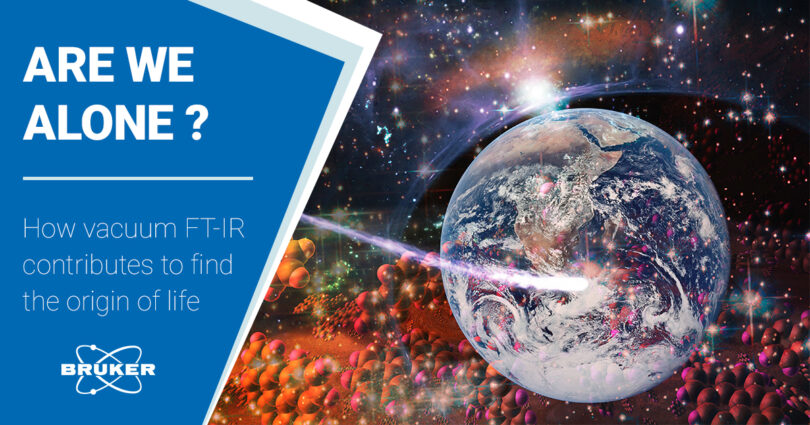How vacuum FT-IR contributes to find the origin of life
What is the true origin of life (OOL)? The answer would satisfy mankind’s curiosity regarding the central existential issue. Out of the deep-sea vents? In volcanic clouds sparked by lightning? Initialized on clay? Origin on earth or hitchhiked on comets? Different theories on OOL have been set by scientists. The answer remains unknown, and it continues to be one of the most intriguing and challenging questions in science.
The Heidelberg Initiative for the Origin of Life (HIFOL) also seeks to understand this most fundamental question for humanity: how did life emerge on Earth and whether life exists elsewhere in the Universe. Astrophysicists, Geoscientists, Chemists and Biologists work together, each tackling different aspects of the same problem. In their recent research work published in Nature Astronomy Th. Henning and co. proved experimentally that the condensation of Carbon atoms on the surface of cosmic dust (ice mantles) leads to the formation of amino ketene molecules out of three of the most abundant species (CO, C and NH3) present in star-forming molecular clouds. The amino ketene further polymerizes to produce peptides. The researchers present a novel and more efficient pathway to form biopolymers, that skips the stage of amino acids formation, even at low temperatures. To test this reaction pathway experimentally, CO, C and NH3 have been co-deposited on substrates cooled to 10K and placed inside an ultrahigh vacuum (UHV) chamber to mimic the conditions in dense molecular clouds. In-situ characterization was performed by IR spectroscopy during temperature rise from 10K to 300K. Combined with quantum chemical calculations and mass spectrometric analysis this non-energetic pathway could be approved.
A Bruker VERTEX 80v vacuum spectrometer was adapted to the UHV chamber to realize in-situ IR spectroscopy. Thanks to the aluminum housing the vacuum spectrometer can be mechanically easily and reliably adapted to the chamber ports via vacuum compatible (e.g. standard CF) flanges. The UHV chamber with amazingly low background pressure of 10-10 mbar and the vacuum optics bench of VERTEX 80v (5mbar) are separated via one UHV window. Since the pressure difference is not as big as UHV to 1 atmosphere, window materials with low hardness can be considered (like KBr), which is optimized for maximal throughput and higher sensitivity in FT-IR spectroscopy. Furthermore, the port windows are not directly exposed to lab air (moisture) but constantly protected under vacuum. Also the entire beam path, from spectrometer to sample in UHV chamber and to the external evacuated detector chamber is completely protected under (rough or ultra-high) vacuum to ensure utmost performance. Indeed, this is the instrumental prerequisite for such demanding research projects. An astonishing sensitivity to measure weak bands down to 10-5 au (absorbance units), temporal resolution to detect short-lived intermediate species and no disturbing atmospheric absorption are the remarkable contributions of vacuum FT-IR to assure success.
Bruker is highly experienced in offering specialized UHV FTIR solutions. We have successfully installed adaptions for different UHV systems manufactured by various UHV suppliers and used in plenty of research institutions worldwide. Flexible solutions to adapt UHV chambers of almost all dimensions and designs to meet individual experimental requirements and laboratory layout can be provided. And we will continue to improve our knowledge and assist scientists for more and more discovery and advancement.








